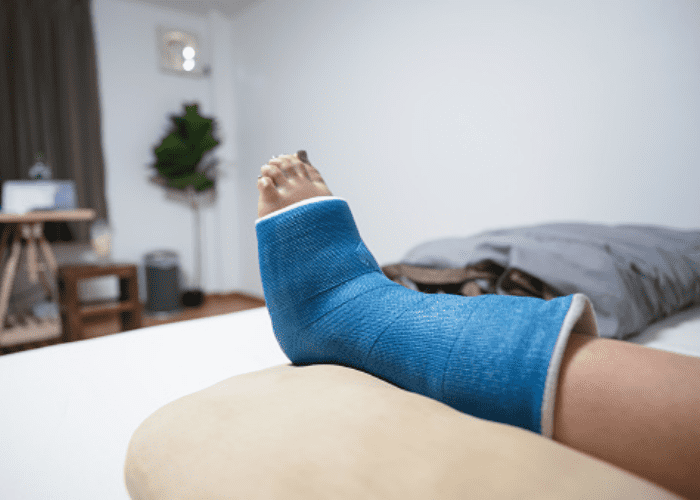Foot injuries can be painful and take some time to heal. Is the thought of not being able to get a good night’s sleep after foot surgery keeping you awake at night?
After foot surgery, you will need to lay on your back with your foot on a couple of pillows. It is important to raise your foot above your heart while sleeping to help reduce swelling after surgery. Directly after surgery, you may be required to keep your foot elevated for up to 72 hours.
Here are a few tips for sleeping after bunion surgery:
- Elevate your foot: To help reduce swelling and improve circulation, try elevating your foot above the level of your heart while you sleep. You can use pillows or a foam wedge to do this.
- Use a comfortable and supportive pillow: Choose a pillow that is comfortable and supportive, and that helps reduce pressure on your foot and ankle. A body pillow or a pillow with a “u” shape can be especially helpful.
- Sleep in a comfortable position: Experiment with different sleeping positions to find one that is comfortable and does not put too much pressure on your foot or ankle. Sleeping on your back or side may be most comfortable.
- Wear loose-fitting clothing: Choose clothing that is loose and comfortable, and that does not rub or chafe against your foot or ankle.
- Avoid sleeping on your stomach: It is generally best to avoid sleeping on your stomach after bunion surgery, as this can put pressure on your foot and ankle and cause discomfort.
- Talk to your doctor: If you are having difficulty sleeping after bunion surgery, you should talk to your doctor or healthcare provider. They may be able to suggest additional strategies or techniques that can help you get a good night’s sleep.
Overall, it is important to find a comfortable and supportive position that allows you to sleep comfortably after bunion surgery. Experimenting with different pillows and positions may help you find a position that works for you.
How do you sleep after ankle surgery?
After any surgery, sleep is an important part of the healing process, so finding a good way of how to sleep after ankle surgery will be critical to your healing process.
Postoperatively you will experience some swelling and pain around your ankle. With the use of prescribed painkillers, the pain should be manageable and, in most cases, will subside after a few days.
For the first 72 hours and possibly longer, you will be sleeping on your back with your foot elevated a minimum of 6 inches above your heart.
Elevating your foot will reduce swelling and any throbbing sensation you may feel.
Your surgeon may permit you to sleep on your side after 72 hours, but if you can remain laying on your back, especially if you are waiting for bones to knit together.
Is it okay to sleep on your side after ankle surgery?
Finding a way to sleep after ankle surgery will be dictated by the kind of surgery you have undergone. Your surgeon will advise you of the best way to sleep.
Sleeping on your side can be done during the healing process of ankle surgery, providing you have pillows to support your knees and ankles.
Depending on the type of ankle surgery and how far into the healing process you are, it is possible to cause damage such as dislocation in some cases, so great care needs to be taken.
What is the fastest way to recover from bunion surgery?
Follow the surgeon’s instructions and rest well. You will be required to wear a surgical boot to protect the bones after the bunion has been operated on.
Wearing a bunion boot or shoe will help with the pain, and it is permissible to sleep with the boot or shore on.
Bunions are painful, and the surgery can leave you in pain, so finding a way of how to sleep after bunion surgery is crucial to your recovery process.
Your bunion shoe will need to be on your foot for 23 hours every day. If you can’t sleep with the shoe on your foot, you can use bunion splints.
Like most foot surgery, you will need to sleep with your foot elevated at least 6 inches above your heart (a couple of pillows will do the job).
The recovery period after bunion surgery can be long. Even a simple bunion surgical procedure can see you off your foot for 8 weeks.
How can I sleep at night after foot surgery?

You will always be required to sleep on your back with your foot elevated above your heart after foot surgery.
Not all foot surgery is the same, so it’s crucial to find how to sleep after foot surgery as it is an important part of the healing process.
After minor surgery, you can sleep on your back for up to 72 hours with your foot elevated to reduce swelling. This will be the minimum requirement for any foot surgery and will be extended further with the complexity of the healing process.
After some surgeries on your foot, it’s possible to sleep on your side after 72 hours if there is no danger of causing further injury to your foot or ankle.
When you transition from sleeping on your back to side sleeping, you will need adequate support from a pillow between your knees and feet.
How long does the pain last after ORIF?
The worst of the pain lasts for approximately 72 hours but can be managed with prescribed painkillers and anti-inflammatories.
It is normal to have mild pain for up to 5 weeks after surgery.
The bigger issue is sleeping after ORIF surgery, and you will certainly need to learn the best way to sleep after ORIF surgery.
You will need to sleep on your back with your leg elevated to reduce swelling and avoid blood pooling around the injury site.
It will be 6 to 8 weeks before you will be allowed to place any weight on the leg or foot. During this period, you will almost certainly experience swelling and pain together with a stiffness of the joints in the lower leg and possibly the knee.
How long should you elevate your hand after carpal tunnel surgery?
At least 24 hours. Carpal tunnel surgery can be painful, so you will need to learn how to sleep after carpal tunnel surgery.
Your hand will be heavily bandaged with a splint for two weeks, so sleeping should not be a big deal. Sleep with enough pillows by your side to elevate the elbow and hand above the heart to reduce swelling.
Your doctor will possibly advise you to wiggle your fingers to alleviate some of the swelling and stiffness.
You can experience soreness after carpal tunnel surgery for up to 3 months post-surgery.
How do you sleep with ulnar nerve compression?
After ulnar nerve surgery, the patient will need to learn how to sleep after ulnar surgery to speed healing and limit pain.
Try not to flex your elbow, have a pillow you can place your elbow on above your heart to help reduce swelling for at least 48 hours to establish healing. Your arm will possibly be in a splint to prevent movement.
Your fingers should be in a flat position or a natural at-rest position for your hand and fingers.
Ice packs are permitted to help reduce inflammation from the surgical site and offer additional pain relief.





